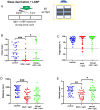The psychoactive effects of Bryophyllum pinnatum (Lam.) Oken leaves in young zebrafish
- PMID: 35263358
- PMCID: PMC8906576
- DOI: 10.1371/journal.pone.0264987
The psychoactive effects of Bryophyllum pinnatum (Lam.) Oken leaves in young zebrafish
Abstract
Bryophyllum pinnatum (Lam.) Oken (BP) is a plant that is used worldwide to treat inflammation, infections, anxiety, restlessness, and sleep disorders. While it is known that BP leaves are rich in flavonoids, the extent of the beneficial and toxic effects of its crude extracts remains unclear. Although some neurobehavioral studies using leaf extracts have been conducted, none has examined the effects of water-extracted leaf samples. The zebrafish is a powerful animal model used to gain insights into the efficacy and toxicity profiles of this plant due to its high fecundity, external development, and ease of performing behavioral assays. In this study, we performed behavioral testing after acute exposure to different concentrations of aqueous extract from leaves of B. pinnatum (LABP) on larval zebrafish, investigating light/dark preference, thigmotaxis, and locomotor activity parameters under both normal and stressed conditions. LABP demonstrated dose-and time-dependent biphasic effects on larval behavior. Acute exposure (25 min) to 500 mg/L LABP resulted in decreased locomotor activity. Exposure to 300 mg/L LABP during the sleep cycle decreased dark avoidance and thigmotaxis while increasing swimming velocity. After sleep deprivation, the group treated with 100 mg/L LABP showed decreased dark avoidance and increased velocity. After a heating stressor, the 30 mg/L and 300 mg/L LABP-treated groups showed decreased dark avoidance. These results suggest both anxiolytic and psychoactive effects of LABP in a dose-dependent manner in a larval zebrafish model. These findings provide a better understanding of the mechanisms underlying relevant behavioral effects, consequently supporting the safe and effective use of LABP for the treatment of mood disorders.
Conflict of interest statement
The authors have declared that no competing interests exist.
Figures





References
-
- The Plant List. Version 1.1. Published on the Internet. 2013. http://www.theplantlist.org/ (accessed December 20, 2021).
-
- Rodrigues E, Tabach R, Galduróz JCF, Negri G. Plants with possible anxiolytic and/or hypnotic effects indicated by three Brazilian cultures—Indians, Afro-Brazilians, and river-dwellers. In: Studies in Natural Products Chemistry. 2008; 35:549–595. doi: 10.1016/S1572-5995(08)80014-2 - DOI
-
- Pereira KMF, Grecco SS, Figueiredo CR, Hosomi JK, Nakamura MU, João Henrique GL. Chemical composition and cytotoxicity of kalanchoe pinnata leaves extracts prepared using Accelerated System Extraction (ASE). Nat Prod Commun. 2018;13:163–166. doi: 10.1177/1934578x1801300213 - DOI
-
- Fernandes JM, Cunha LM, Azevedo EP, Lourenço EMG, Fernandes-Pedrosa MF, Zucolotto SM. Kalanchoe laciniata and Bryophyllum pinnatum: an updated review about ethnopharmacology, phytochemistry, pharmacology and toxicology. Rev Bras Farmacogn. 2019;29(4):529–558. doi: 10.1016/j.bjp.2019.01.012 - DOI
Publication types
MeSH terms
Substances
Grants and funding
LinkOut - more resources
Full Text Sources
Miscellaneous

